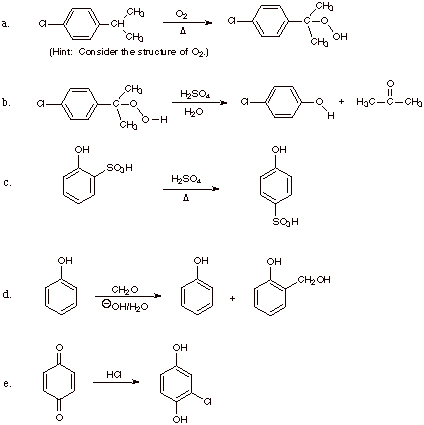![]()
![]()
Nitrogen Functional Groups and Phenols
1. Treatment of the compound shown below with iodomethane led to the formation of two isomeric products, A and B. When each of these was treated first with Ag2O/H2O followed by heating, there was formed the same mixture of compounds C and D. Compound C could be resolved into enantiomers but D could not.
a. Provide structures for A and B and indicate the structural relationship between them.
b. Provide structures for C and D.
2. Compound A, C7H15NO, was neutral and exhibited strong absorption in the infrared spectrum at 1652 cm1 but none in the 3200-3400 cm1 region. Extended heating of A with H3O+/H2O gave compound B and, after addition of NaOH, a nitrogen-containing compound C. B exhibited strong absorption in the infrared spectrum at 1712 cm1 and a very broad absorption over the range 2500-3500 cm1. The 1-H NMR spectrum of B consisted of the following absorptions: 1.20 ppm (d, rel. area 6, J = 7.0 Hz), 2.41 ppm (septet, rel. area 1, J = 7.0 Hz), and 12.40 ppm (s, rel. area 1). Compound C exhibited a single absorption at 3335 cm1 in the infrared spectrum and reacted with nitrous acid at 0 °C to give a yellow oil. Compound C was synthesized by treating ethyl amine first with formic acetic anhydride and then with LiAlH4 (H3O+ work up). Provide structures for A, B, and C which are consistent with this evidence.
3. Compounds A, B, and C all have a molecular formula of C10H12O2 and their IR and NMR spectra show that they are all p-disubstituted benzenes. All of these compounds are water insoluble. Compound A is insoluble in both NaOH and NaHCO3. Compound B is soluble in both NaOH and NaHCO3, and compound C is soluble in NaOH but insoluble in NaHCO3. Give structures for A, B, and C, consistent with this information.
4. Explain the relative acidities of several phenols as shown below. (Hint: Consider the structures of the phenolate ions.)

5. Give a reasonable mechanism for each the following reactions. Use curved arrows to show movement of electron pairs and "fish hooks" to show the movement of single electrons.
